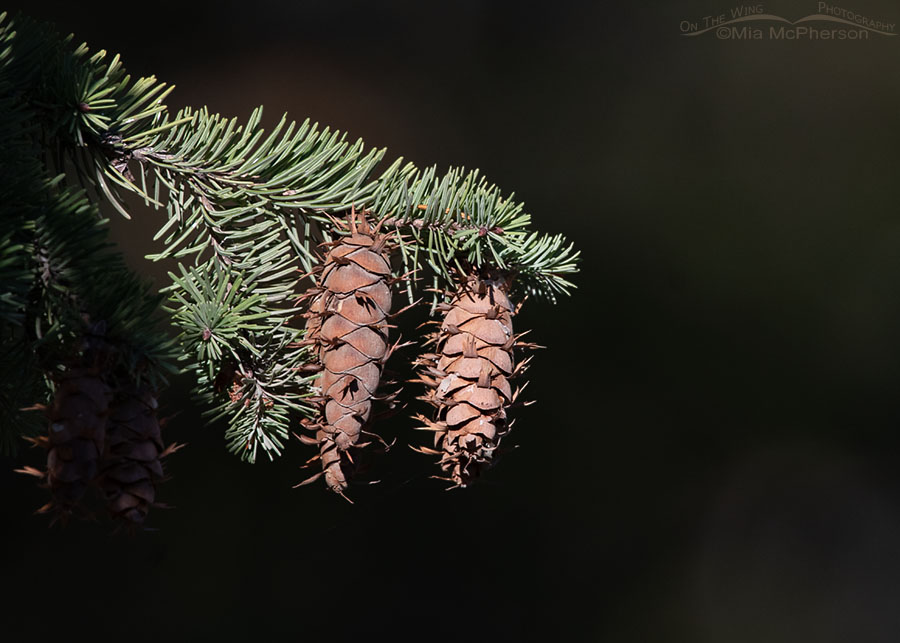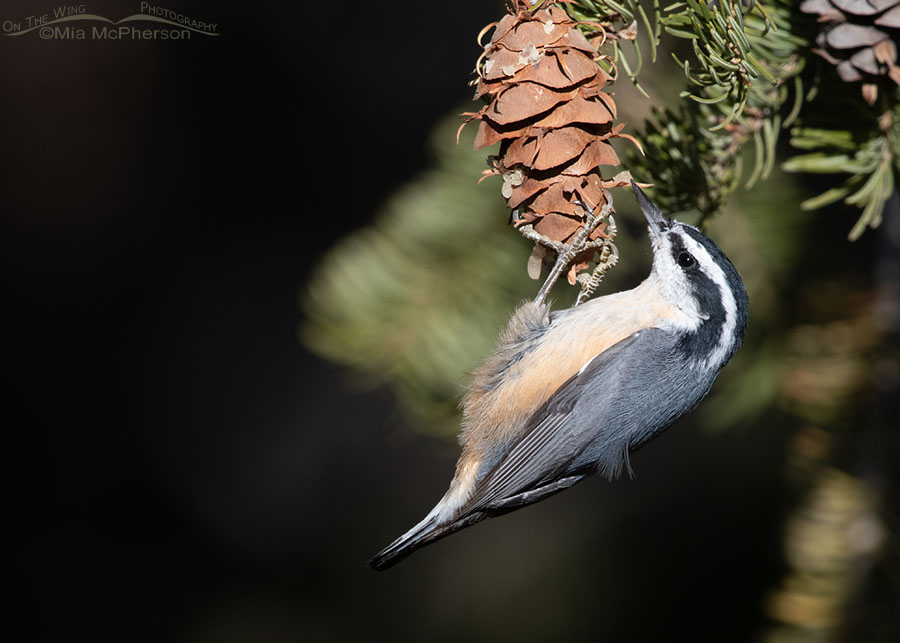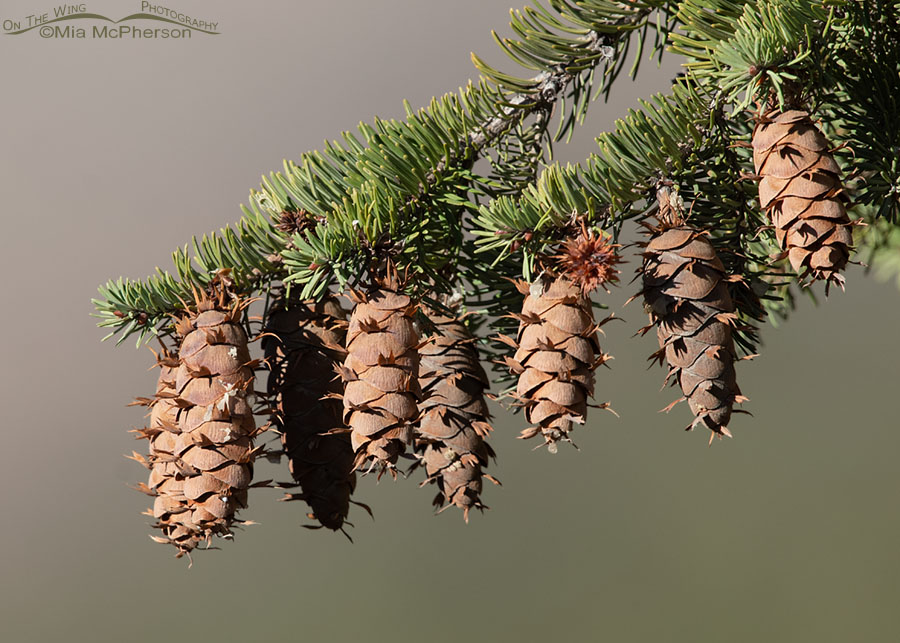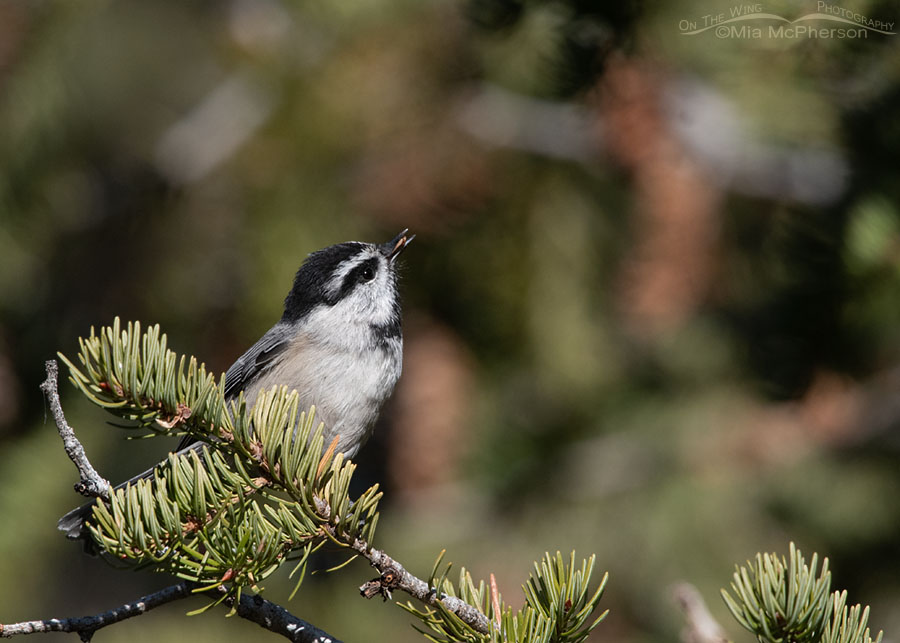 Douglas Fir cones in a spot of sunlight – Nikon D500, f7.1, 1/1250, ISO 640, -0.7 EV, Nikkor 500mm VR with 1.4x TC, natural light,
Douglas Fir cones in a spot of sunlight – Nikon D500, f7.1, 1/1250, ISO 640, -0.7 EV, Nikkor 500mm VR with 1.4x TC, natural light,
My trip out into the sky island mountains of the West Desert last week caused my concerns about this years crop of Douglas Fir seeds to grow. On a previous trip out there earlier in the month I was concerned because I didn’t hear the calls of Red-breasted Nuthatches or Mountain Chickadees that should have been in the area feeding on and caching the seeds of the Douglas Firs. At that time I thought I might not be hearing the birds that feast on the seeds because the fir cone scales still hadn’t opened up enough for the birds to grasp the seeds. When I was up in the mountains last Thursday I could see that the cone scales had opened more.
 Red-breasted Nuthatch checking out a Douglas Fir cone in autumn – Nikon D500, f7.1, 1/1250, ISO 800, -0.7 EV, Nikkor 500mm VR with 1.4x TC, natural light,
Red-breasted Nuthatch checking out a Douglas Fir cone in autumn – Nikon D500, f7.1, 1/1250, ISO 800, -0.7 EV, Nikkor 500mm VR with 1.4x TC, natural light,
But I didn’t hear the call of a single Red-breasted Nuthatch or Mountain Chickadee last week. I also didn’t hear the calls of Pine Siskins which also eat the Douglas Fir seeds. The only bird calls I heard in the area of the fir trees were a few Dark-eyed Juncos and a Townsend’s Solitaire. There weren’t even any White-crowned Sparrows to be seen.
It was strangely quiet for this time of the year. I hear Red-breasted Nuthatches year round in that location and honestly to not even hear one put me on edge. I should have heard plenty of bird calls and songs.
 Douglas Fir cones on October 21, 2021 – Nikon D500, f7.1, 1/640, ISO 640, Nikkor 500mm VR with 1.4x TC, natural light,
Douglas Fir cones on October 21, 2021 – Nikon D500, f7.1, 1/640, ISO 640, Nikkor 500mm VR with 1.4x TC, natural light,
I checked out several of the Douglas Fir trees and I could see that the scales of the cones had loosened enough for the nuthatches and chickadees to pull the seeds out but now I am wondering if the birds know that the seed production of this years crop of the Douglas Fir trees at this specific location have failed or somehow aren’t nutritious enough because of the exceptional drought conditions we have experienced this year in northern Utah.
In hindsight I believe I should have picked a cone to bring home so I could examine the seeds.
 Mountain Chickadee eating a Douglas Fir seed – Nikon D500, f7.1, 1/2000, ISO 800, -0.7 EV, Nikkor 500mm VR with 1.4x TC, natural light,
Mountain Chickadee eating a Douglas Fir seed – Nikon D500, f7.1, 1/2000, ISO 800, -0.7 EV, Nikkor 500mm VR with 1.4x TC, natural light,
What I do know is that it was strange that there weren’t any birds feeding on the seeds from the cones of these Douglas Firs during a time period when the branches should be full of them flitting around eating and gathering seeds to cache and store for winter consumption. It felt eerie to me.
I hope to go back out there sometime this week when the weather is better and the roads are drier to check on this puzzling situation and when I do I hope that I will find chickadees and nuthatches feeding on the seeds. It would certainly ease my concerns.
Life is good.
Mia
Douglas Fir trees in other areas of northern Utah may or may not have been affected by the drought as these have been. The cones of these opened weeks later than normal. The nuthatch and chickadees photos were taken in November of 2019.
Click here to see more of my flower, shrub and tree photos. Click here to see more of my Red-breasted Nuthatch photos plus facts and information about this species. Click here to see more of my Mountain Chickadee photos plus facts and information about this species.





I really feel for you. Drought is terrifying and its impacts are huge.
If you had taken a cone home, what would you have looked for to determine its health?
Margot, I would have looked at the seeds to see if they were shriveled looking or appeared desiccated. I’ve seen enough healthy firs seeds that I would be able to tell if the drought has affected them.
Have you read this wonderful book? Douglas Fir: The Story of the West’s Most Remarkable Tree
Sadly we are going to experience a lot more of these heartbreaks in the coming years.
Scary!
We have noticed an absence of birds in our area this year (St. George/Ivins) as well. It is very disturbing and yes, way to quiet.